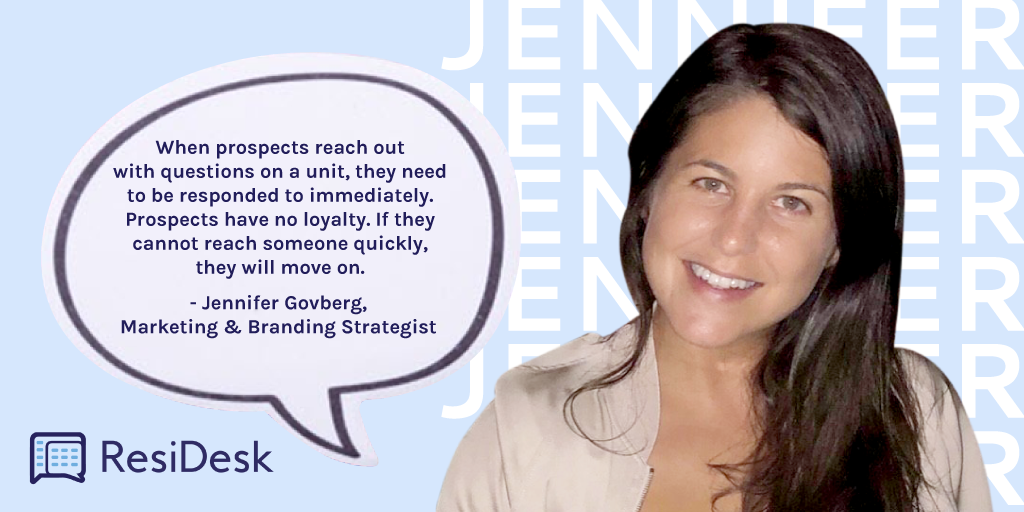
Welcome to ResiDesk's property management spotlight, where we highlight the experiences and best practices of residential real estate professionals. We hope they are insightful and maybe even entertaining! Want to be featured? We’d love to chat with you.
Spotlight on: Jennifer Govberg, Leasing Professional
Jennifer Govberg has strong leadership and marketing insight into property management. She has directed and worked with leasing agents at two Philadelphia real estate firms, working as the Director of Marketing & Operations at BG Capital LLC and as a Leasing Manager at Allan Domb Real Estate.
Jennifer's background includes multi-family, MOB, and bar/restaurant developments, where she has worked alongside some of the top brokers and leasing agents in the country. In today's spotlight, Jennifer shares what working as a leasing manager is like, including her experiences during the height of COVID pandemic lockdowns.
Describe a typical day as a leasing manager during COVID lockdowns?
My day was based around turnovers. I ran a residential division on 1,000 units, and the work associated with turnovers took a lot of time. The buildings I looked after were 30+ years old, so vacancies required more than a quick paint and clean. I was organizing and prioritizing work with contractors to get units ready when face-to-face meetings were difficult and added to the workload.
I was a one-person show for my units and was overseeing work with a lot of different vendors. I had many tracking numbers to stay on top of and high vacancies and agents to manage. At the beginning of COVID, we were restricted from physical showings, which introduced its own set of complications in dealing with "sight unseen".
What was team communication like?
We had weekly leasing meetings as a group, and then I would talk off and on with agents throughout the day via text and calls. Many of the agents were 1099 employees breezing through resident and prospect queries, and I was the connector between the unit owners and tenants. I represented the owners' best interests and negotiated on their behalf on all work orders and costs.
In our weekly team meetings, we would dive right into agent numbers. We would assess how many leases came in that week, how many were pending, and how many were pending approval—this sounds straightforward enough; however, it was never that easy. Agents would indicate scenarios like having 16 leases in and five pending, however in the following month, they would only close ten, and upper management would be frustrated. Unfortunately, part of the issue came from a lack of transparency throughout the team.
What were some of the key challenges?
It can be challenging working with a significant number of 1099 agents. Agents who are driven by a salary and bonus structure tend to make themselves more available to prospective tenants. When prospects reach out with questions on a unit, they need to be responded to immediately. Prospects have no loyalty. If they cannot reach someone quickly, they will move on. And if you have properties with a high number of, say, college students who are prone to late-night communications, you will lose those leads if you're not responsive outside of regular business hours.
How can leasing agents optimize their work?
Staying on top of transmittals can be tricky for agents. They need to use a spreadsheet or similar tool to keep on top of where they are in the leasing process with each lead. They need to consistently gauge how many times a lead has come in, what the situation is, how many times they've reached out to them, how (or if) the prospect has responded, and on and on until the last leasing document is signed. Being disorganized here is a severe hindrance and can lose opportunities.
I would often coach our newer leasing agents, spending a lot of time showing them how to organize their work—from following up leads to prioritizing properties and units. It's an essential skill that makes the job easier.
Do you have any advice for leasing managers?
Good software that gives you an overview of your leasing agents makes a huge difference. You need to be able to tie back conversions to the right agent and benchmark conversion efforts.
Additionally, using an app that allows you to process applications swiftly is a terrific time-saver to take advantage of. There are a lot of documents that require signing, from the actual lease to all the addendums. It's amazing how many agents still do this through zipped files, with all the individual fields requiring manual entry. With the right app, you can simply send a link to a prospect with all the files prepopulated from your property management system (if integrated), saving time and preventing a lot of aggravation for leasing agents.

Additional Resources
Quickly Attract Tenants, Close Deals, & Reduce Churn With Smart Inboxes
Tenant Communications: Speed is a Powerful Differentiator
Lessons in Multifamily Asset Management: Getting your hands dirty